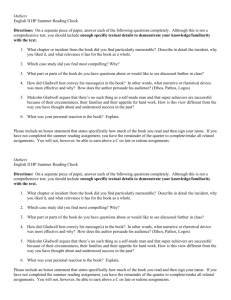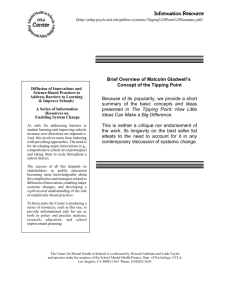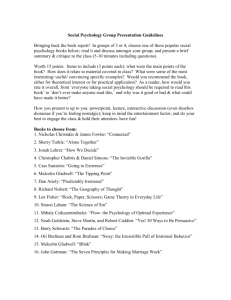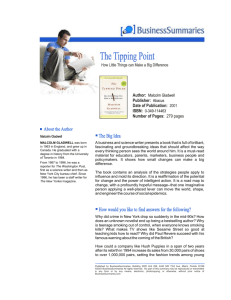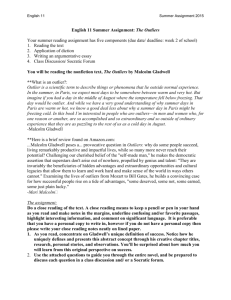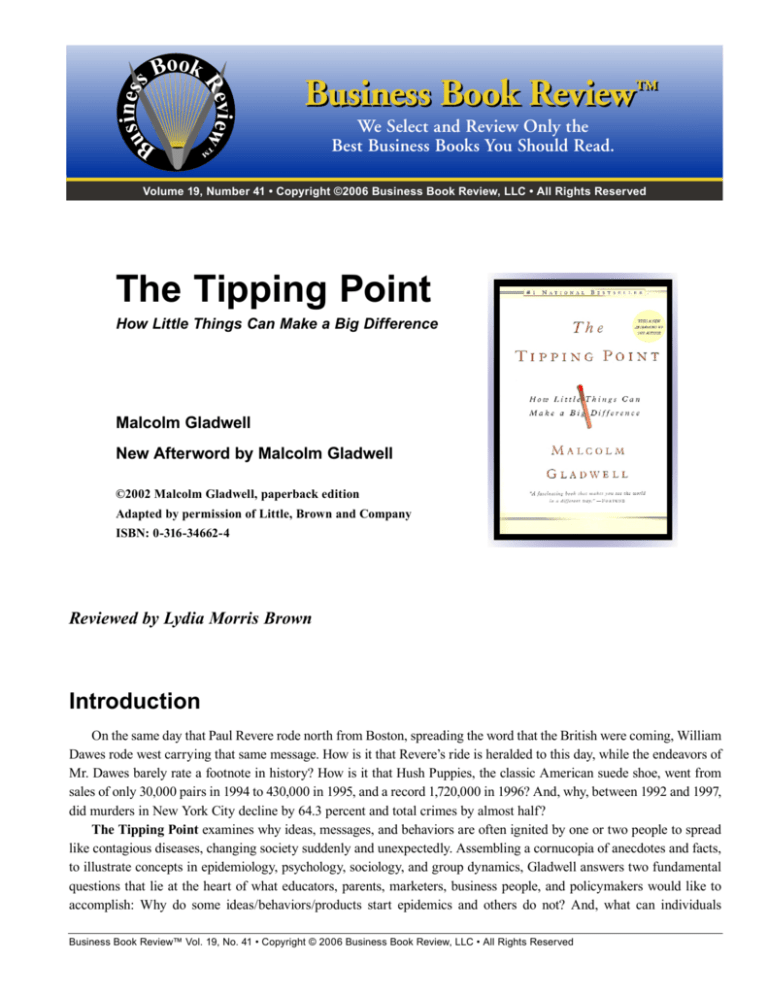
Business Book Review™
™
usiness
vie
Re w
Book
We Select and Review Only the
Best Business Books You Should Read.
B
Volume 19, Number 41 • Copyright ©2006 Business Book Review, LLC • All Rights Reserved
The Tipping Point
How Little Things Can Make a Big Difference
Malcolm Gladwell
New Afterword by Malcolm Gladwell
©2002 Malcolm Gladwell, paperback edition
Adapted by permission of Little, Brown and Company
ISBN: 0-316-34662-4
Reviewed by Lydia Morris Brown
Introduction
On the same day that Paul Revere rode north from Boston, spreading the word that the British were coming, William
Dawes rode west carrying that same message. How is it that Revere’s ride is heralded to this day, while the endeavors of
Mr. Dawes barely rate a footnote in history? How is it that Hush Puppies, the classic American suede shoe, went from
sales of only 30,000 pairs in 1994 to 430,000 in 1995, and a record 1,720,000 in 1996? And, why, between 1992 and 1997,
did murders in New York City decline by 64.3 percent and total crimes by almost half?
The Tipping Point examines why ideas, messages, and behaviors are often ignited by one or two people to spread
like contagious diseases, changing society suddenly and unexpectedly. Assembling a cornucopia of anecdotes and facts,
to illustrate concepts in epidemiology, psychology, sociology, and group dynamics, Gladwell answers two fundamental
questions that lie at the heart of what educators, parents, marketers, business people, and policymakers would like to
accomplish: Why do some ideas/behaviors/products start epidemics and others do not? And, what can individuals
Business Book Review™ Vol. 19, No. 41 • Copyright © 2006 Business Book Review, LLC • All Rights Reserved
The Tipping Point
deliberately do to start and control positive epidemics of
their own?
PART I: EPIDEMICS AND THE PRINCIPLES OF
EPIDEMIC TRANSMISSION
In 1994, Wolverine, the company that makes Hush
Puppies—the classic American brushed- suede shoe—had
just about decided to phase out this once famous brand. Sales
had fallen to 30,000 pairs annually, mostly to backwoods
outlets and small-town family stores. Then, in 1995, the
company sold 430,000 pairs. The next year, it sold almost
2 million pairs, and the year after that, still more. Suddenly,
Hush Puppies were once again a staple of the young
American-male wardrobe.
In 1992, New York City experienced 2,154, and 626,182
serious crimes were reported. But then, at some mysterious
and critical point, the crime rate tipped. Within five years,
murders had dropped 64.3 percent to 770 and total crimes
fell by almost half to 355,893.
According to Gladwell these occurrences are textbook
examples of epidemics in action and illustrate the premise
that ideas, products, messages, and behaviors spread in
the same manner as do viruses. The rise of Hush Puppies
and the fall of a city’s crime rate may not seem to have
very much in common; however, they share a fundamental
pattern: First, they are typical of how contagion spreads.
Second, in both cases, little changes had big effects. And,
third, both changes occurred rapidly.
These three characteristics mirror the three principles
that define how an outbreak of measles moves through a
grade school, or how the flu attacks every winter. However,
the third trait is the most important. It is the principle that
makes sense of the first two and that provides the greatest
insight into why modern change occurs the way it does. It
is what Gladwell calls the Tipping Point—that one dramatic
moment in an epidemic when everything changes all at
once.
From 1995 to 1996, the number of children born with
syphilis increased by 500 percent in the city of Baltimore.
The Centers for Disease Control believed that crack cocaine
was the little push that syphilis needed to become a raging
epidemic. John Zenilman, a John Hopkins expert on
sexually transmitted diseases, thought that the breakdown
of medical services in the city’s poorest neighborhoods
was the cause. And, John Potterat, a leading epidemiologist
Malcolm Gladwell
Key Concepts
The Tipping Point—the Place Where the
Unexpected Becomes Expected
1. The best way to understand ideas, products,
messages, behavior, and any of the mysterious
changes that mark everyday life is to think
of them as epidemics, which spread in the
same manner as do viruses. Thus,
contagiousness is an unexpected property of
all kinds of things.
2. In epidemics, little changes can somehow have
big effects.
3. And, in epidemics, change happens, not
gradually, but at one dramatic moment. The
name given to that one dramatic moment, when
everything can change all at once, is the
Tipping Point.
4. Nonetheless, there is more than one way to tip
an epidemic: via the carriers who transmit
infection (the Law of the Few), via the infectious
agent itself (the Stickiness Factor), and via
the environment in which the infectious agent is
operating (the Power of Context).
5. When an epidemic tips, it is jolted out of its
equilibrium because some change has
occurred in one or more of these arenas
*
*
*
Information about the author and subject:
www.gladwell.com
Information about this book and other business titles:
www.twbookmark.com
blamed it on a diaspora that occurred in East and West
Baltimore at the time.
Potterat noted that, for years, syphilis had been confined
to these specific regions of Baltimore until two housing
projects were demolished and people also began moving
out of the old row houses in the same neighborhoods. With
this housing dislocation, people were forced to live in other
parts of the city, and they took their syphilis and their
sociosexual behaviors with them.
Gladwell maintains that there are two striking elements
about these three explanations. The first is that none
Business Book Review™ Vol. 19, No. 41 • Copyright © 2006 Business Book Review, LLC • All Rights Reserved
Page 2
The Tipping Point
Malcolm Gladwell
suggests any dramatic occurrence (i.e., it takes only
The Law of the Few is an example of the 80/20 Principle
the smallest change to shift an epidemic’s equilibrium
of economics, which is the idea that in any situation, roughly
significantly). Crack had existed in Baltimore for years, but
80 percent of the work will be done by 20 percent of the
a subtle increase in the severity of the problem was enough
participants. It is a principle that explains why 20 percent
to set off the syphilis epidemic. The
STD clinics were not shut down “The three rules of the Tipping Point—the Law of the Few, the
completely; the number was just Stickiness Factor, the Power of Context—offer a way of making
sense of epidemics. They provide us with direction for how to go
scaled back from 17 to 10. And,
about reaching a Tipping Point.”
all of Baltimore was not hollowed
out. It simply took the demolition
of all motorists cause 80 percent of all accidents, 20 percent
of a handful of housing projects, and the abandonment
of beer drinkers drink 80 percent of all beer and, in most
of homes in some key downtown neighborhoods, to send
societies, 20 percent of the criminals commit 80 percent
syphilis soaring.
of all crimes.
The second fact about the three explanations (and
However, when it comes to epidemics, says Gladwell,
Gladwell believes that this is perhaps the more interesting of
this disproportion becomes even more extreme: a tiny
the two) is that all describe a very different way of tipping
percentage of people do the majority of the work (i.e., in
an epidemic. In suggesting that the introduction and growth
a given process or system, some people matter more than
of an addictive drug can so change the environment that a
others). Accordingly, the success of any kind of social
disease tips as a result, the CDC was talking about overall
epidemic is heavily dependent on the involvement of people
context. However, Zenilman’s assertions were about the
with a particular set of social gifts—people the author calls
disease itself. When the clinics were cut back, syphilis
Connectors, Mavens, and Salesmen, who control word-ofwas given a new life, transforming from acute infection to
mouth epidemics.
chronic infection.
Even in this era of mass communications, word of
As for Potterat, he focused on the people. He maintained
mouth is still the most important form of human
that the disease was carried by a particular kind of
communications. In fact, many advertising executives
individual—very poor, sexually active, and probably
believe that, precisely because marketing efforts are so
drug-using. And, when this kind of person is suddenly
ubiquitous today, word-of-mouth appeals have become
transported to a new location, where syphilis was never
the only kind of persuasion that most people respond
before a problem, the disease would have an opportunity
to anymore. Nonetheless, word of mouth remains very
to tip—to be jolted out of equilibrium.
mysterious. People pass on all kinds of information to each
Because it seems as though epidemics are a function
other all the time. However, it is only rarely that such an
of the people who transmit infectious agents, the infectious
exchange ignites an epidemic.
agent itself, and the environment in which the agent
This is where Connectors and the concept of six
operates, epidemics are, thus, tipped in more than one way.
degrees of separation come in. Six degrees of separation
Gladwell calls these three agents of change The Law of the
does not mean that everyone is linked to everyone else in
Few, the Stickiness Factor, and the Power of Context.
just six steps, but that a very small number of people are
About the Author
Malcolm Gladwell, who worked as a science
reporter and then as a New York City bureau
chief for the Washington Post (1987 to 1996), is
now a staff writer for The New Yorker. He is also
the author of the bestselling Blink: The Power of
Thinking Without Thinking.
linked to everyone else in a few steps. The rest are linked
to the world through those special few. Thus, word of mouth
is not one person telling another about a new restaurant,
and that person telling a friend, who tells another, and so
on. Rather, it begins when, somewhere along the chain,
someone tells a Connector.
These special few—these Connectors—are people
whom all of us can reach in only a few steps because,
for one reason or another, they manage to occupy many
Business Book Review™ Vol. 19, No. 41 • Copyright © 2006 Business Book Review, LLC • All Rights Reserved
Page 3
The Tipping Point
Malcolm Gladwell
different worlds, subcultures, and niches, and to bring them
all together. This ability to span many different words is a
function of something intrinsic to their personality—some
combination of curiosity, self-confidence, sociability, and
energy that helps them relate to the people they meet. While
most individuals constantly choose whom they would like
to know and reject those who do not look right, who live
in the “wrong” place, or those whom they have not seen in
years, Connectors choose to know everyone.
feelings, which means that they are far more emotionally
contagious than most. “There are carriers, people who
are very expressive, and there are [also] people who are
especially susceptible. It’s not that emotional contagion
is a disease. But the mechanism is the same” (Hatfield,
Cacioppo, and Rapson, Emotional Contagion).
It is a well-known principle in virology that not only
do epidemics tip because of the extraordinary efforts of a
few select carriers, sometimes they also tip when something
happens to transform the epidemic itself.
“These people who link us up with the world, who bridge ... who
Take, for example, the infamous flu
introduce us to our social circles—these people on whom we
pandemic of 1918. When the flu broke
rely more heavily than we realize—are Connectors, people
out in the spring of that year, it was
with a special gift for bringing the world together.”
relatively tame. But over the summer, the
Just as there are specialists, connecting people to
virus underwent some strange transformation and ended up
people, there are also other specialists—Mavens—who
killing between 20 and 40 million people, worldwide, over
connect people to information. (Gladwell notes that,
the next six months.
sometimes, these two specialists are one and the same.)
Nothing had changed in the way in which the virus was
Known as either “price vigilantes” or “Market Mavens,”
being spread. Rather, the virus had suddenly become much
they have information on many different products, prices,
more deadly. This, says Gladwell, is the Stickiness Factor,
and/or places, and they can be found in every walk of life
and it has enormous implications for the way social, as
and in every socioeconomic group.
well as viral, epidemics are regarded. It says that there are
Yes, they are obsessed with how to get the best deal;
specific ways of ensuring that a message makes an impact
however, when they figure out how to do this, they want
(i.e., manages not not go in one ear and out the other).
to tell others. They are socially motivated experts, and this
Most people, as well as many marketers, talk loudly
is what sets them apart. It is not so much what they know
and repeat what they have to say, over and over, in order
but how they pass it along. Gladwell contends that the fact
to ensure that what they say is remembered. However,
that Mavens want to help, for no other reason than they
Gladwell notes that direct marketers (the real students
like to help, represents a more compelling recommendation
of stickiness) have found that small and subtle are more
(and an extremely effective means of getting someone’s
effective. In other words, in a society overwhelmed by a glut
attention) than the opinion of the paid expert.
of information, what is needed is a subtle, but significant,
A Connector might tell 10 people where to stay in
change in presentation (one that makes the information
Los Angeles, and half of them might take this advice. A
more practical and personal) rather than an avalanche of
Maven might tell five people where to stay, but make the
new or additional information. Thus, the key is not in the
case so emphatically that all of them take the advice. Thus,
inherent quality of the idea presented; instead, the key is to
they are different personalities at work, acting for different
tip the message by tinkering on the margin, with an idea’s
reasons, but they both have the power to spark word-ofstructure and format.
mouth epidemics: As “data banks,” Mavens provide the
As Zenilman found, epidemics are strongly influenced
message, and as the “social glue,” Connectors spread it.
by their context—the circumstances, conditions, and
Gladwell notes, however, that for social epidemics to start,
particulars of the environments in which they operate.
people must be persuaded to actually do something. This
Thus, the Power of Context says that human beings are
is where Salesmen come in. They are a select group with
much more sensitive to their environment than they may
the skills to sway those who are unconvinced.
seem. Moreover, the kinds of contextual changes that are
Salesmen have an enormous amount of influence over
capable of tipping an epidemic are very different than what
others. They are very good at expressing emotions and
might ordinarily be expected.
Business Book Review™ Vol. 19, No. 41 • Copyright © 2006 Business Book Review, LLC • All Rights Reserved
Page 4
The Tipping Point
Malcolm Gladwell
During the 1990s, violent crime declined across the
Broken Windows theory and the Power of Context say
U.S. for a number of fairly straightforward reasons: The
just the opposite. They propose that criminals are acutely
illegal trade in crack cocaine began to decline. The economy
sensitive to the environment, alert to all kinds of cues, and
experienced a dramatic recovery. And, the general aging
prompted to commit crimes, based on their perception of
of the population meant that there were fewer people in the
the world around them.
age range (males between 18 and 24) that is responsible for
In the 1960s, liberals talked about the importance of
the majority of all violence.
environment in terms of such fundamental social factors
During this same period, crime also decreased in New
as injustice, structural economic inequities, unemployment,
York City, but for reasons that are a little more complex. For
racism, and decades of institutional and social neglect; thus,
one thing, the city’s economy was not
“Criminals do not ... sound like the kind of people who could be
only stagnant, recent welfare cuts had
swept up by the infectious winds of an epidemic. Yet somehow,
made the poorest neighborhoods even
in New York City, this is exactly what occurred. ... For some
poorer. The decline in crack-cocaine
reason tens of thousands of those people suddenly stopped
trafficking was a factor, but it had been committing crimes.”
in steady decline well before crime
dipped. Due to heavy immigration in the 1980s, the city’s
stopping crime would require heroic steps. However, the
population was getting younger rather than older. And,
Power of Context says that little things in the environment
whereas the effects of these kinds of trends are usually
matter most. Even the felonies occurring in New York
gradual, in New York, they were anything but. Gladwell
City’s subway system could be prevented by doing away
maintains that something else, which criminologists James
with the small expressions of disorder—graffiti and fareQ Wilson and George Kelling call the Broken Windows
beaters—which invite more serious crime.
theory, clearly played a role in reversing the city’s epidemic
Gladwell believes that the implications of this idea
of violence.
are enormous. He notes that the old understanding of
It is their contention that if a window is broken and left
handling crime epidemics leads to a preoccupation with
unrepaired, people will conclude that no one is in charge
defensive measures—putting extra locks on the door to
and no one cares. Soon more windows will be broken, and a
slow the burglar down, incarcerating criminals longer,
sense of anarchy will spread, sending a signal that anything
and/or moving to the suburbs—that do little in the way of
goes—graffiti, public disorder, aggressive panhandling,
prevention. However, once people understand that specific
mugging, robbery, etc. Thus, the impetus to engage in
and relatively small elements in the environment (i.e., things
a certain kind of behavior is not coming from a certain
that they can actually change), can serve as Tipping Points,
kind of person but from a feature of the environment. A
their defensive defeatism is turned around.
proliferation of broken windows becomes an invitation for
The author has found that small close-knit groups
individuals to commit more serious crimes, simply because
also have the power to magnify the epidemic potential
the environment tells them they can get away with it.
of a message or idea. For those interested in starting an
Gladwell notes that most of the formal explanations
epidemic (i.e., reaching a Tipping Point), there is a simple
for criminal behavior talk about criminals as people with
tenet that distinguishes a group with real social authority
stunted psychological development or as people who have
from a group with little power. He calls this tenet the Rule
had pathological relationships with their parents and, thus,
of 150—another unexpected way in which context affects
lack adequate role models. Relatively new literature talks
the course of social epidemics.
about genes that may or may not dispose individuals to
Channel capacity, a concept in cognitive psychology,
crime. And, there are those who talk about crime as a
says that human beings can only handle so much
consequence of the moral failure of parents, schools, and
information at once before becoming overwhelmed. This
communities.
describes intellectual capacity—the ability to process raw
Essentially, these theories see the criminal as persons
information. However, the most interesting natural limit is
who are insensitive to the norms of normal society. The
perhaps what can be called social channel capacity. British
Business Book Review™ Vol. 19, No. 41 • Copyright © 2006 Business Book Review, LLC • All Rights Reserved
Page 5
The Tipping Point
Malcolm Gladwell
anthropologist Robin Dunbar argues that humans socialize
in the largest groups of all primates because humans are
the only animals with brains big enough to handle the
complexities of that social arrangement.
Plugging in the neocortex ratio for Homo sapiens, he
found a group estimate of 147.8 (approximately 150), which
“seems to represent the maximum number of individuals
with whom we can have a genuinely social relationship, the
kind of relationship that goes with knowing who they are
and how they relate to us.”
Thus, Gladwell concludes that if groups are to serve
as incubators of contagious messages, they must be kept
below the 150 Tipping Point. Above that point, structural
impediments emerge that block the ability of the group to
By contrast, the Early Majority are big companies that
must worry about how any change fits into their complex
arrangement of suppliers and distributors. The goal of
these pragmatists is to make incremental, measurable, and
predictable progress.
Because the two attitudes are fundamentally
incompatible, all kinds of high-tech products fail, never
making it beyond the Early Adopters. The companies that
make these products cannot seem to find a way to transform
an idea that makes perfect sense to an Innovator into one that
makes perfect sense to a member of the Early Majority.
Gladwell believes that this is where Connectors,
Mavens, and Salesmen play their most important role
(although Moore’s argument is entirely concerned with high
technology, it also applies to other
“Innovators try something new. Then someone ... a Maven or a
kinds of social epidemics). These
Connector or a Salesman ... sees it and adopts it. “[They] make
special Few are the ones who make it
things more palatable for mainstream people. They see what the
possible for innovations to bridge the
really wired ... are doing. ... They start doing it themselves, but
gap between Early Adopters and the
they change it a bit. They make it more usable.’ ”
Early Majority. They take ideas and
agree and act with one voice. Thus, crossing the 150 mark
information from a highly specialized world and translate
is a small change that can make a big difference, and this
them into a language that everyone else can understand. It
is the paradox of the epidemic: that in order to create one
is a process that can be analyzed by looking at rumor, the
contagious movement, one often has to create many small
most contagious of all social messages.
movements first.
Psychologists have found that a process of distortion is
nearly universal in the spread of rumors. For example, in
PART II: THE FEW, THE STICKY, AND CONTEXT IN
memory experiments, subjects were given a story to read or
EVERYDAY LIFE
a picture to look at and then asked to reproduce what they
Gladwell acknowledges that sometimes the problems
had been shown. It was found that, invariably, significant
and situations people face in everyday life do not always
leveling occurred. Although all but a few details were
embody the principles of epidemics so neatly. For example,
dropped, certain details were also sharpened. Sociologist
Geoffrey Moore argues that there is a substantial difference
Gordon Allport (The Psychology of Rumor) concluded that
between the people who originate technological trends and
in the subjects’ effort to create meaning they condensed or
ideas and the people who eventually take them up. These
filled in so as to achieve a better “Gestalt ... a simpler, more
two groups may be next to each other on the word-of-mouth
significant configuration.”
continuum, but they do not communicate with each other
This is what Gladwell means by translation. In order
especially well.
to make an idea contagious, Mavens, Connectors, and
Innovators/Early Adopters are visionaries who want
Salesmen alter it in such a way that extraneous details are
revolutionary change—something qualitative that sets
dropped and others are exaggerated so that the message
them apart from their competitors. They are just starting out
itself acquires a deeper meaning. Thus, if anyone wants to
with their small companies, but they are willing to take the
start an epidemic, whether it is of Hush Puppies, behavior,
risk of buying new technology before it has been perfected,
or technology, he or she must employ Connectors, Mavens,
or proven, or before the price comes down. Their goal is to
and Salesmen to translate the message of the Innovators into
make a quantum leap forward.
something the rest of the world can understand.
Business Book Review™ Vol. 19, No. 41 • Copyright © 2006 Business Book Review, LLC • All Rights Reserved
Page 6
The Tipping Point
Malcolm Gladwell
Teenage smoking is another of the great, baffling
to suicides. David Phillips, a UC San Diego sociologist, has
phenomena of modern life—a form of self-expression that
found that highly publicized suicides give other people,
in many ways mirrors Micronesia’s teen suicide epidemic.
particularly those vulnerable to suggestion, permission to
In the early 1960s, suicide in Micronesia was almost
engage in a deviant act as well. “Suicide stories are a kind
unknown. Then, mysteriously, it began to rise, steeply and
of natural advertisement for a particular response to your
dramatically, until by the end of the 1980s, there were more
problems.”
suicides per capita than anywhere else in the world.
People who die in highly publicized suicides—those
For males between 15 and 24, the suicide rate in
whose deaths give others “permission” to die—are the
the islands is about 160 per 100,000—more than seven
functional equivalents of Salesmen and serve as s Tipping
times higher than it is in the U.S. Thus, suicide has
Poinst in word-of-mouth suicide epidemics. Moreover, the
become commonplace, triggered by the smallest incidents.
“permission” given is not a general invitation, but a highly
Teens take their own lives because they
“As suicide grows more frequent in these [Micronesian]
see their girlfriends with another boy,
communities the idea itself acquires a certain familiarity if not
because their parents refuse to give them
fascination to young men, and the lethality of the act seems to
a few extra dollars for beer or money
be trivialized.”
for a graduation gown, or because they
--Donald Rubinstein
are rebuked for making too much noise.
What is rare and random in Western cultures has become,
detailed set of instructions, specific to certain people in
in Micronesia, an adolescent ritual, with its own particular
certain situation, who choose to die in certain ways. Thus,
rules and symbols.
it is not a gesture but a speech.
In virtually all cases, the victim is male, in his late
Teen smoking follows this same logic. Gladwell
teems, unmarried, and living at home. The precipitating
questioned adult smokers and found that smoking seems
event is invariably domestic—a dispute with girlfriends
to evoke a vivid, precise, emotionally charged childhood
or parents. In most instances, the victim had never before
memory associated with sophistication. Respondents
tried or even threatened suicide. The suicide notes tend to
consistently described the particular individual (the
express a kind of wounded pride and self pity (a protest
“Salesman”) who initiated them into smoking in precisely
against perceived mistreatment) rather than depression.
the same way: as an extrovert, who craves excitement,
The act itself typically occurs on a weekend night after a
takes chances, and is defiant, sexually precocious, honest,
bout of drinking with friends. And, in all but a few cases,
indifferent to the opinions of others, impulsive, and
the victim observes the same procedure (almost a strict
aggressive. It is an almost perfect definition of the kind
protocol) for taking his life.
of person to whom many adolescents are drawn. These
According to anthropologist Donald Rubinstein, as the
individuals are not cool because they smoke, they smoke
number of suicides has grown, the idea has fed upon itself,
because they are cool.
infecting younger and younger boys, transforming itself
This simple point is essential in understanding why the
from something unimaginable to something compelling,
war on smoking has stumbled so badly. (Since 1988, the
and embedding itself in the local culture. This is why,
total number of teen smokers in the U.S. has risen by 73
says Gladwell, the suicide epidemic in Micronesia is
percent.) The anti-smoking movement has railed against the
so potentially relevant to the smoking problem—also a
tobacco industry for making smoking cool and has tried to
contagious epidemic of self-destruction, engaged in by
convince teenagers that smoking is not hip. However, the
youth, in the spirit of experimentation, imitation, rebellion.
point is that smoking was never perceived as being hip but
In both cases, it is a matter of mindless action that somehow
smokers are perceived as such. This epidemic is the same as
has become an important form of self-expression.
Micronesia’s suicide epidemic, word-of-mouth epidemics,
Those who study suicide have observed that in some
or the AIDS epidemic. They all began because of the
places and under some circumstances, the act of one person
extraordinary influence of a select few Salesmen.
taking his or her own life can be contagious—suicides lead
Business Book Review™ Vol. 19, No. 41 • Copyright © 2006 Business Book Review, LLC • All Rights Reserved
Page 7
The Tipping Point
Malcolm Gladwell
In addition to illustrating the Law of the Few, the teen
smoking epidemic is also an excellent illustration of the
Stickiness Factor. Whether a teenager picks up the habit
depends on whether he or she has contact with one of the
Salesmen who give teenagers “permission” to engage in
deviant behavior. This is contagiousness, which is in large
part a function of the messenger.
But whether a teen likes cigarettes enough to keep
using them depends on a different set of criteria—the
individuals’ own particular initial reaction to nicotine.
This is the Stickiness Factor, and it is primarily a property
this broad, seemingly comprehensive campaign, teenage
smoking has skyrocketed. He suggests that, instead of
trying to tackle whole problem in this way, society needs to
deal with the stickiness Tipping Points, which he believes
are linked to depression and to the nicotine threshold.
Preliminary evidence has found that smoking and
depression might have the same genetic root. Depression is
believed to be the result, at least in part, of a problem in the
production of key brain chemicals, serotonin, dopamine, and
norepinephrine, which contribute to feelings of confidence,
mastery, and pleasure. While such drugs as Zoloft and
Prozac ameliorate depression because
“Nicotine addiction ... is far from an instant development. It takes they prompt the brain to produce
time for most people to get hooked on cigarettes, and just
more serotonin, nicotine prompts the
because teens are smoking at fifteen doesn’t mean that they
brain to produce more dopamine and
will inevitably become addicted. You’ve got about three years to
norepinephrine. Not only do some
stop them.”
smokers find it difficult to stop because
they are addicted to nicotine, but also
of the message. People who did not get a buzz from their
because
without
nicotine,
they run the risk of a psychiatric
first cigarette and who found the experience so awful they
illness.
never smoked again are probably those whose bodies are
It turns out, then, that if smokers are treated for
acutely sensitive to nicotine and incapable of handling even
depression, their smoking habit may be a lot easier to
the smallest doses.
break. Glaxo Wellcome has tested the antidepressant, now
Chippers are people, who, like social drinkers, remain in
marketed under the name of Zyban, in heavily addicted
control of their habit. Every smoker starts out as a chipper;
smokers, and found remarkable results. The drug’s initial
however, some remain chippers, never escalating to heavy
success has proven that it is possible to find a sticky Tipping
smoking. Perhaps they have the genes to derive pleasure
Point with smoking by zeroing in on depression and, thus,
from nicotine, but not the genes to handle it in large doses.
exploiting a critical vulnerability in the smoking-addiction
Meanwhile, heavy smokers may be people with the genes
process.
to do both. Nicotine is also known to relieve boredom and
Gladwell has also found a second potential Tipping
stress; thus, those who are in boring or stressful situations
Point
on the stickiness question, having to do with how
will smoke more than people who are not.
smoking addiction develops. When teens first experiment
The critical point, often lost in the war-on-smoking
with cigarettes, they are all chippers, and most quit, never
rhetoric, is that what makes smoking contagious is
smoking again. A few continue to chip for many years,
completely different from the kinds of things that make it
without becoming addicted. And, about a third end up as
sticky. This means that when looking for Tipping Points in
regular smokers. However, it takes about three years to go
the war on smoking, it must be decided which side of the
from casual to regular smoking, and then, there is a gradual
epidemic will be the most susceptible to attack. “Should we
escalation for the next five to seven years. Thus, there is
try to make smoking less contagious, to stop the Salesmen
a three-year window to stop smoking from becoming an
who spread the smoking virus? Or are we better off trying
addiction.
to make it less sticky, to look for ways to turn all smokers
In addition, nicotine addiction is not a linear
into chippers?”
phenomenon. It seems as though there is an addiction
As Gladwell notes, the anti-smoking campaign has
Tipping Point—a threshold. People who smoke below a
focused on raising prices, curtailing advertising, running
certain number of cigarettes (it is not exactly the same
public health messages, limiting minors’ access, and foiling
for all individuals) are not addicted at all. But, if they go
the influence of smoking Salesman. Nonetheless, during
Business Book Review™ Vol. 19, No. 41 • Copyright © 2006 Business Book Review, LLC • All Rights Reserved
Page 8
The Tipping Point
above that number, they suddenly are. Neal Benowitz and
Jack Henningfield, thought to be world’s leading nicotine
experts, have made the educated guess that chippers are
people able to smoke up to five cigarettes a day (between
four and six milligrams of nicotine) without getting
addicted.
Thus, they suggest that tobacco companies be required
to lower the level of nicotine so that even the heaviest
smokers (approximately 30 cigarettes a day) could not get
anything more than five milligrams of nicotine within a 24hour period. They argue that this level “should be adequate
to prevent or limit the development of addiction in most
young people. At the same time it may provide enough
nicotine for taste and sensory stimulation.”
Teens would continue to experiment with cigarettes
because the habit is contagious, because cool kids are
smoking, and because they want to fit in (the same reasons
they have always experimented). But, if nicotine levels are
reduced below the addiction threshold, the habit would no
longer be sticky. “Cigarette smoking would be less like
the flu and more like the common cold: easily caught but
easily defeated.”
*
* *
Bibliographic notes by chapter and a subject
index are provided.
Remarks
The idea for Tipping Point came from Gladwell’s
coverage of the AIDS epidemic when he was a reporter
with the Washington Post. In learning about HIV, he was
struck by the assumptions epidemiologists (those who study
epidemics) have about how and why change happens and
by how different these assumptions are from the way the
rest of us view change.
The phrase “Tipping Point” comes from this
serendipitous world. It’s the name given to that moment
in an epidemic when a virus reaches critical mass. When
depicted on a graph, the Tipping Point is that point at which
the line on the graph suddenly shoots straight up. Fascinated
by this concept, Gladwell asked, “What if Tipping Points
Malcolm Gladwell
also occur outside the medical realm, in every arena of
society and, if they do, what are the practical implications
for individuals, organizations, and communities?”
The Tipping Point is the “biography” of that discovery—
the simple idea that “Contagiousness [i.e., the epidemic] ...
is an unexpected property of all kinds of things, and we
have to remember that, if we are to recognize and diagnose
epidemic change.” The examples Gladwell uses to illustrate
this idea—Paul Revere’s ride, the Hush Puppies trend, the
popularity of Sesame Street, the rise of the Divine Secrets
of the Ya-Ya Sisterhood to bestseller status, the decline of
crime in New York, the emergence of the Methodist Church,
the Columbia Record Club treasure hunt, teen suicide and
smoking, among others—demonstrate that contagiousness
is not just a metaphor; it has real relevance in every sphere
of our lives.
We emphasize the phrase “every sphere” to highlight
the fact that this is no simple marketing how-to book.
Yes, it presents a powerful and practical framework for
developing insights into how to find the critical mass for
products, innovations, and messages. However, it goes
beyond this business application to provide out-of-the-box
(but cogent) thinking about the counterintuitive basics
of human behavior—thinking that can have a salutary
effect on how society deals with the drug addicted, the
Columbines, AIDS, the conditions that spawn a Bernie
Goetz, and much more.
Although The Tipping Point is about change, and
a way of understanding why change often happens so
precipitously, it is also about hope in the form of “Band-Aid”
remedies (“the inexpensive, convenient, and remarkably
versatile [and effective] solution to an astonishing array of
problems) and “the power of one.”
Reading Suggestions
Reading time: 15-17 hours, 313 Pages in Book
Although The Tipping Point is a synthesis of scientific
research in epidemiology, psychology, sociology, and group
dynamics, the science is nimbly illustrated with studies,
examples, and anecdotes that speak to the general reader.
Despite this accessibility, Gladwell does, however, tend
to be long-winded and iterative, revisiting and tweaking
each facet of each key concept, time and again, from
Business Book Review™ Vol. 19, No. 41 • Copyright © 2006 Business Book Review, LLC • All Rights Reserved
Page 9
The Tipping Point
Malcolm Gladwell
chapter to chapter. (Chapter 3, “The Stickiness Factor:
Sesame Street, Blue’s Clues, and the Educational Virus” is
especially dense). Moreover, you will find the paragraphs
to be exceptionally long—many taking up almost an entire
page and, thus, failing to provide the reader with much
respite. These minor flaws will, however, neither detract
from the book’s relevance nor prevent you from realizing
new avenues of understanding and action.
Given the potential obstacles to your forward momentum,
we suggest that you plan your reading schedule carefully,
prepare to read only one chapter at a sitting (you may need
several sittings to assimilate chapter 3 fully), and even set
aside time to reflect on the material you’ve covered. A good
portion of what you read may contradict the sense you’ve
made of your world, so will need time to do your own
tweaking and reassessing.
We believe that an excellent preparation for this task is
to read the introduction, conclusion, and afterword before
tackling the remainder of the text. This approach may help to
whet your appetite and keep you focused through Gladwell’s
iterations. Knowing the destination will keep you energized
as you navigate the many double S-turns you will encounter
along the way. Here again, we recommend pacing yourself
by perhaps reading the introduction, conclusion, and
afterword in, at least, two stages.
CONTENTS
Chapter 1: The Three Rules of Epidemics
Chapter 2: Connectors, Mavens, and Salesmen
Chapter 3: Sesame Street, Blue’s Clues, and the
Educational Virus
Chapter 4: Bernie Goetz and the Rise and Fall of New
York City Crime
Chapter 5: The Magic Number One Hundred and Fifty
Chapter 6: Rumors, Sneakers and the Power of
Translation
Chapter 7: Suicide, Smoking, and the Search for the
Unsticky Cigarette
Chapter 8: Focus, Test, and Believe
Afterword: Tipping Point Lessons from the Real World
Business Book Review™ Vol. 19, No. 41 • Copyright © 2006 Business Book Review, LLC • All Rights Reserved
Page 10
The Tipping Point
Malcolm Gladwell
A Note to Our Readers
We at BBR encourage our readers to purchase the business books we review. BBR Reviews are intended as
a service to busy professionals, as we recommend only those books that are worth your time to read in their
entirety. We apply stringent criteria in selecting only the best business books, and in that selection process,
strive to help you make informed book-purchasing decisions.
This book is available at bookstores and online booksellers.
Business Book Review™ is a service of Business Book Review, LLC
For more information about BBR, to subscribe to BBR,
or to provide us feedback, visit our Web site.
www.businessbookreview.com
Business Book Review, LLC
1549 Clairmont Road, Suite 203
Decatur, GA 30033
Copyright © 2006 Business Book Review, LLC • All Rights Reserved
No copies may be made of this review unless appropriate license has been granted.
ISSN 0741-8132
Business Book Review™ Vol. 19, No. 41 • Copyright © 2006 Business Book Review, LLC • All Rights Reserved
Page 11




